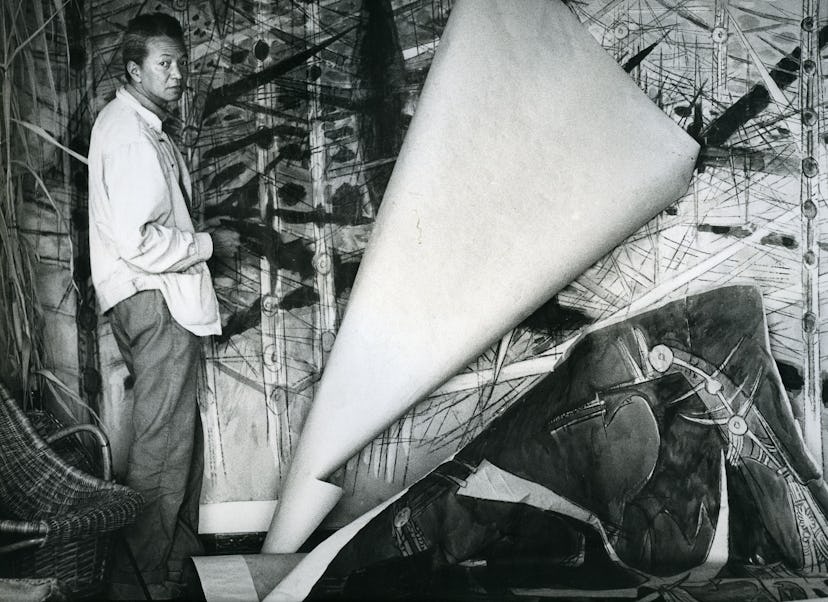A Cuban in Paris

After this week’s grand unveiling of the late artist Wifredo Lam’s retrospective at the Centre Pompidou in Paris, Isabelle Bscher—who represents the third generation of women to run Galerie Gmurzynska, the longtime Swiss art dealership with outposts in Zug and Zurich—trotted out of the museum in a glamorous white frock and walked in heels onto the cobblestoned streets of the Marais. Waiting for her in a centuries-old theater-turned-restaurant was a rollicking late dinner complete with a foie gras cart, mojitos (a nod to Lam’s native Cuba), and a swath of collectors from various ports of call. Bscher’s family represents the Wifredo Lam estate, and this show is decades in the making.
“It was long overdue,” she said at the party, sitting next to Diana Widmaier-Picasso, the granddaughter of Wifredo’s friend Pablo, and Thierry L’Hermitte, “the most famous actor in France,” Bscher explained, helpfully.
“Finally,” she went on, “people get to see the artist he really was.”
At a time when we’re thisclose to Havana being a three-hour commercial flight from New York, which would bring more contemporary Cuban artists and collectors into the art world fold, the Pompidou’s expansive retrospective is actually trying to advance the idea that Lam is more than just “the Cuban Picasso.” Although Cuba is his homeland, that’s just where he got started: Lam was born to a black mother and a Chinese father and spent his life darting from the fronts of the Spanish Civil War to the surrealist cliques of Paris, to the Cedar Tavern in New York, to Fidel Castro’s Havana, to tiny fishing villages on the Ligurian coast of Italy. The show includes troves of correspondences and old photos, including a letter Alexander Calder wrote from Connecticut in jerky Spanish, and photos of Lam with various lodestars of the avant-garde. It traces a clear line from his early Cubist paintings in Paris to the abstract techniques he adopted while living in New York in the 1950s.
The scene-stealer was placed amid a maze of paintings hung by curator Catherine David; The Jungle is a masterpiece that MoMA acquired in 1945 and, until now, has never lent out to anyone. “The Pompidou, the Reina Sofia, the Tate—the finest institutions in Europe!” exclaimed the dapper Mathias Rastorfer, Galerie Gmurzynska’s CEO, ticking off the museums where the show will travel. “MoMA has interest as well, so that’s the next step.”
Lam’s continent-hopping and mixed heritage—and the way those factors bled into his work—has recently prompted his reclassification in this season’s auction season: instead of being brought to the block during the Latin American sales, it will be among the big guns in the Impressionist and Modern auctions. Rastorfer compared Lam’s background to a market favorite of another era: Jean-Michel Basquiat. “When MoMA acquired The Jungle, the New York Times said there was uproar over purchasing a work by a ‘negro’ artist,” he said. “I knew Basquiat, and he used to say, ‘I’m a famous artist, but I can’t hail a cab.’ And it’s clear that Lam had such an impact on him and his work.”
In the middle of the Marais, the curators and collectors mingled, different dialects humming through the room. But as an unending stream of courses started piling up, it became clear that one table relished this moment more than others: Lam’s children and their families sat contentedly, still drinking as the cleaning crew swept everyone out, celebrating a show they’d waited decades to see.
“Wifredo Lam” is on view through February 15, 2016, at the Centre Pompidou in Paris, Place Georges Pompidou.
Photos: A Cuban in Paris
Portrait de l’artiste, 1963. Wifredo Lam, Ö Albissola Archives. Photo courtesy Centre Pompidou/copyright Adagp, Paris 2015.
Wifredo Lam, “La Junge, 1943.” Photo courtesy Centre Pompidou/copyright Adagp, Paris 2015.
Wifredo Lam, “Autoportrait,” 1926. Photo courtesy Centre Pompidou/copyright Adagp, Paris 2015.
Wifredo Lam, “Fata Morgana.” Photo courtesy Centre Pompidou/copyright Adagp, Paris 2015.
Wifredo Lam, “La Ventana,” 1935. Photo courtesy Centre Pompidou/copyright Adagp, Paris 2015.
Wifredo Lam, “Les Noces, 1947.” Photo courtesy Centre Pompidou/copyright Adagp, Paris 2015.